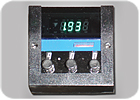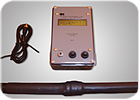
The portable, battery-operated digital tester is capable of providing quantitative indication of quick break quality and shot duration time and is NIST traceable. Source: Scientific Instruments
Quick break detection dates back to the 1950s and is a fast test that confirms function status of “quick break” circuitry in three phase full-wave direct current (FWDC) magnetic particle units. Alterations in the performance of the electrical system of a nondestructive magnetic particle inspection unit can have an effect on the sensitivity of an inspection.
To increase the sensitivity, it is important to have quick break when using these units. Therefore, the electrical system must be checked when the equipment is new, when a malfunction is suspected or every six months, according to the ASTM standard E-1444-01.
Until recently, in order to check the quick break and shot time for magnetic particle inspection units, machine operators had to use testers with flashing neon bulbs or light emitting diodes (LEDs) as indicators. This allowed only for a qualitative indication (such as how bright did the bulb flash?) of quick break quality and the accuracy was debatable (such as did the bulb flash or not?).
This method of quick break detection has a change in sensitivity when exposed to light or handled in the dark because of a change in the neon bulb firing voltage when exposed to light. In addition, the firing voltage could vary from one bulb to the next, which could result in unreliable pass/fail indications.
Previous methods for magnetic pulse duration were limited because the transducer pickup is a resistive current shunt, which provokes a voltage across this resistance as a function of the current passed through, and this voltage is prone to noisy circumstances and erratic triggering as this shunt is not electrically isolated from the customer’s magnetic power supply. By using a resistive shunt for triggering, the operator is not really measuring the magnetic pulse, but instead the current that produces the magnetic pulse. This is another example of how an error in time measurement of the pulse duration can occur.
However, there is now a portable, battery-operated digital tester that is capable of providing quantitative indication of quick break quality and shot duration time and is NIST traceable.
The Dyna-Sense QB-1/QB2 quick break detector from Scientific Instruments (Skokie, IL) uses a microcontroller to analyze the magnetic pulse waveform determining quick break quality and the magnetic shot duration simultaneously.
“The QB-1/QB-2 Quick break detector and shot timer is the new industry standard based on the original military specifications that defined quick break,” says Greg Falk, engineering manager at Scientific Instruments.
Unique features of the unit include a LCD digital readout that quantitatively shows peak quick break voltage facilitating detection of existing degradation of quick break in magnetic unit. This allows for recording of quick break voltage where the operator can track the trend of quick break status and measures up to 29 volts.
Shot time detection reads up to 2.8 seconds with 10 milliseconds resolution on the display. The precision reference air coil transducer gives reliable, repeatable indications of quick break intensity. It is manufactured under controlled conditions, looking for accuracy of inductance, turns and DC resistance.
The tester operates on a 9-volt lithium battery with an approximate time span of 45 hours. If using an alkaline battery, the lifespan is reduced to around 12 hours of continuous use. Other advantages include a magnetic pickup probe that eliminates electrical noise pick up and provides reliable magnetic pulse duration (shot time) measurements.
According to Falk, the idea came about because they were searching for a better way to detect quick break with a method that would provide a quantititative indication that is NIST traceable. The product was in development for one year, which included field testing.
Currently there are three models. The QB1 is just the break tester. The QB2 offers the quick break tester and shot timer for three phase direct current inspection units. The QB3 includes the universal shot duration timer for both AC and DC inspection units.
For more information, contact:
Scientific Instruments
8236 North McCormick Blvd.
Skokie, IL 60076
(847) 679-1242
www.magretrofit.com

Specifications
Accuracy of voltage indication as measured through direct injection of DC voltage source at transducer input jack is 1% of reading, ±2 counts on display least significant digit. Resolution is 0.1 volt.Accuracy of shot time indication (on QB-2 model only) is 1% of reading, ±2 counts on display least significant digit. Resolution is 0.01 second. Timing range is 0.40 to 2.8 seconds.
The transducer coil on the probe is precision wound with very accurate inductance and DC resistance. Never try to use any other type of probe than the one provided with the QB-1/QB-2/QB3 tester.